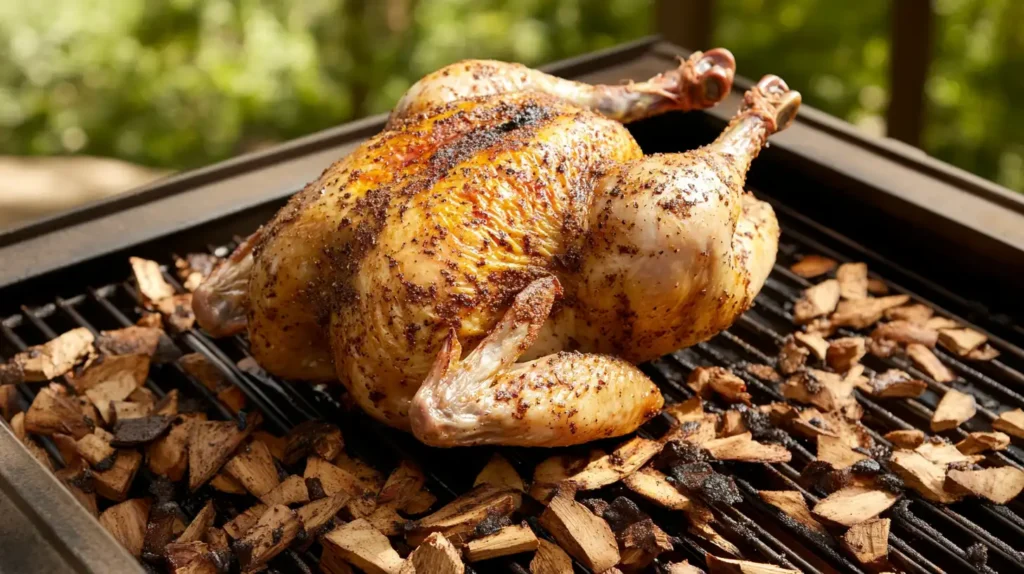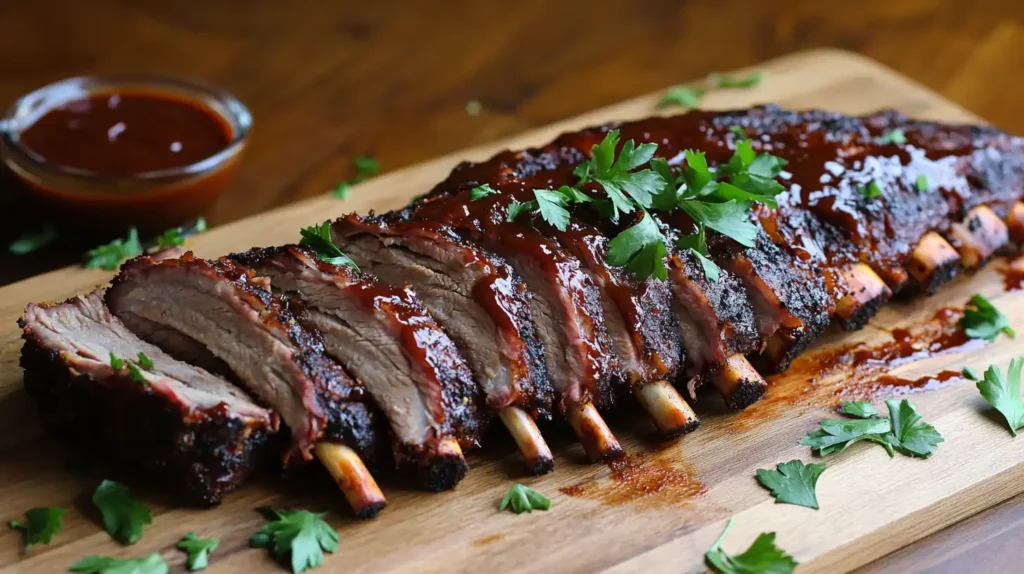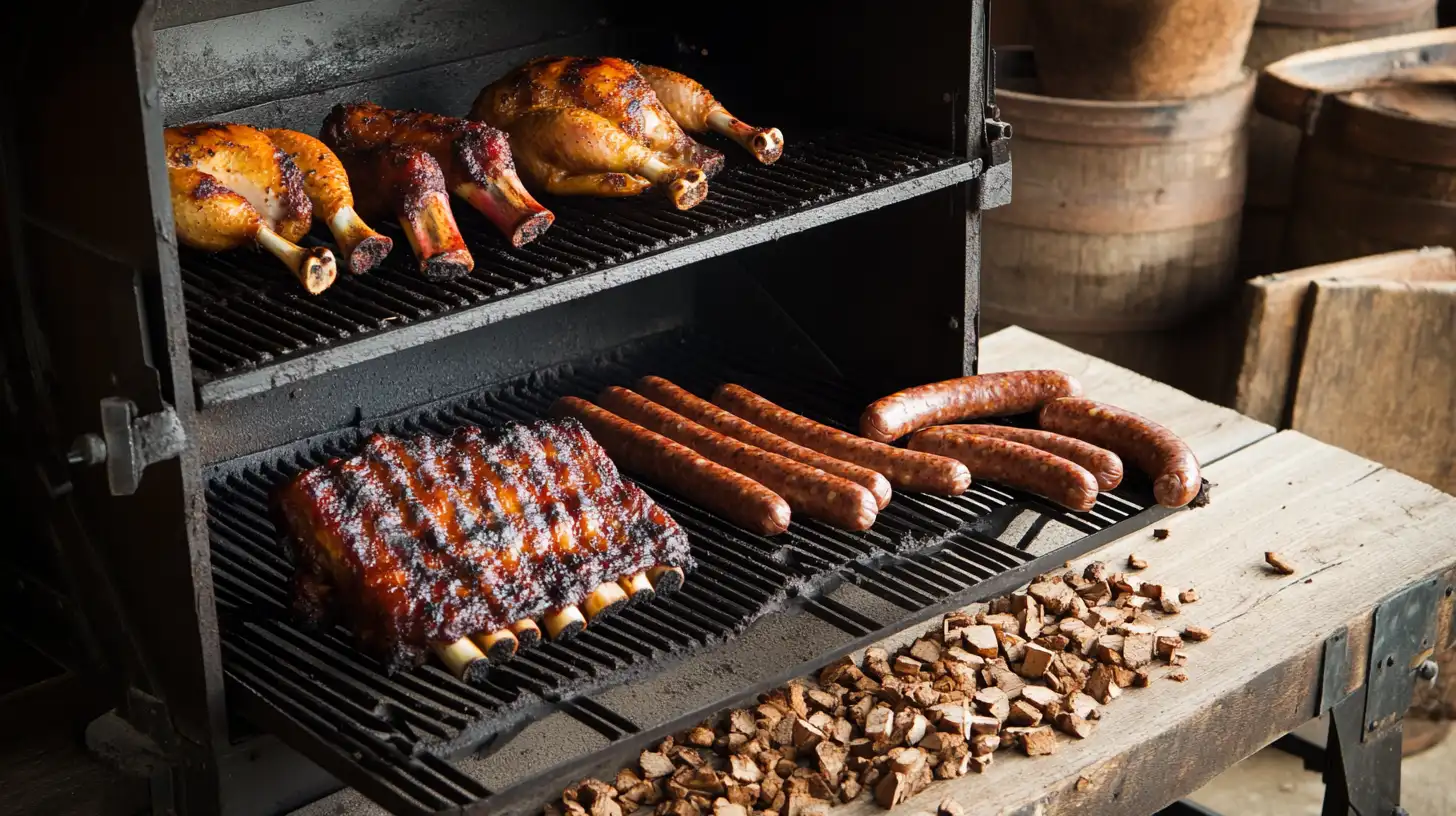What is the best meat to smoke for beginners? This is the first question most people ask when stepping into the flavorful world of meat smoking. Choosing the right meat is essential to your success, especially as a beginner. This article dives into the easiest and most forgiving meats to smoke, essential tips for beginners, and step-by-step techniques to help you master the process.
Table of Contents
Introduction to Smoking Meat
Smoking meat is more than just cooking—it’s an experience that combines time, patience, and a little smoky magic. If you’ve just unboxed your first smoker or are considering venturing into this flavorful realm, it’s essential to choose the right meat to smoke for beginners. Why? Because certain cuts are forgiving and easier to handle, giving you a great introduction to the art of smoking.
What is Meat Smoking?
Meat smoking is a low-and-slow cooking technique that uses indirect heat and smoke from wood chips to cook and flavor the meat. The process tenderizes tougher cuts, adds a distinct smoky flavor, and enhances the overall taste.
Why Beginners Should Choose Specific Meats?
Not all meats are created equal in the world of smoking. Some require precise techniques, while others are forgiving and allow room for error. As a beginner, starting with user-friendly cuts helps you avoid frustration and boosts your confidence.
The Benefits of Starting with the Right Meat
Selecting beginner-friendly meats not only improves your chances of success but also gives you the opportunity to learn key smoking techniques. With the right meat, you’ll focus more on enjoying the process and less on troubleshooting complex recipes. Plus, these meats are affordable and widely available, making them perfect for practice.
Next up, we’ll break down how to choose the best meat to smoke as a beginner and share insights on what makes these cuts ideal for your smoking adventure. Stay tuned!
Criteria for Choosing the Best Meat for Beginners
Choosing the right meat to smoke as a beginner is crucial to your success. It’s not just about flavor—some cuts are easier to handle and less prone to mishaps. Here’s what to look for:
Ease of Preparation and Cooking
For beginners, simplicity is key. Look for meats that don’t require extensive trimming or specialized techniques. Cuts like chicken thighs or turkey legs often come ready to season, making them beginner-friendly. These meats cook evenly and retain moisture, even with minor errors.
Flavor Profile and Forgiveness
Beginner smokers should opt for meats that remain tender and flavorful even if slightly overcooked or under-smoked. For example, chicken and turkey are versatile in their flavor profiles and pair beautifully with a variety of rubs and marinades. Sausages are another excellent choice, as their casings help lock in juices.
Accessibility and Cost
Affordability and availability matter, especially when practicing. Chicken is cost-effective and easy to find at any grocery store. Turkey and sausages, while slightly more expensive, are also widely available and still budget-friendly compared to premium cuts like brisket.
Choosing the best meat to smoke for beginners is a balance of practicality and flavor. In the next section, we’ll highlight specific meats and why they’re perfect for starting your smoking journey.
Top Meats to Smoke for Beginners
So, what is the best meat to smoke for beginners? Let’s dive into the top options that are forgiving, flavorful, and fun to cook:
Chicken: A Simple Start
Chicken is a fan favorite for beginners because it’s affordable and widely available. Whole chickens, thighs, and drumsticks are excellent choices. They’re easy to prep and can be infused with smoky flavors quickly. Pro Tip: Brining chicken before smoking helps retain moisture and enhances the flavor.

Ribs: Beef Short Ribs as a Starter
Beef short ribs are a crowd-pleaser and a great option for beginners. They’re rich in flavor, forgiving, and cook evenly. The marbling in beef ribs keeps them tender even if you over-smoke slightly. Pair them with a simple rub of salt, pepper, and garlic powder for a classic barbecue flavor.

Turkey: Impressively Simple
Turkey is ideal for festive occasions or if you want to try something a little larger. Turkey legs and breasts cook relatively quickly, and their mild flavor makes them a perfect canvas for experimenting with different wood chips like hickory or applewood.
Sausages: An Underrated Starter
Sausages are often overlooked but are perfect for beginners. They require minimal prep and cook quickly, making them great for practicing temperature control. Try a mix of bratwursts or smoked sausages for variety.

These options ensure a hassle-free introduction to smoking while delivering big flavors. Whether you’re smoking chicken for a family dinner or sausages for a backyard barbecue, you’ll build confidence and skills along the way.
In the next part, we’ll explore step-by-step smoking techniques to help you achieve perfect results every time!
Step-by-Step Guide to Smoking for Beginners
Learning how to smoke meat properly is just as important as selecting the best cuts. This step-by-step guide simplifies the process so you can enjoy tender, smoky results every time.
Selecting the Right Equipment
Your choice of smoker matters. For beginners, pellet smokers and electric smokers are great options because they offer consistent temperatures and are easy to use. Charcoal smokers, while traditional, require more hands-on adjustments.
Pro Tip: Always preheat your smoker to the recommended temperature before adding the meat.
Preparing Your Meat: Trimming and Seasoning
Proper preparation is the foundation of good smoked meat. Trim off any excess fat and pat the meat dry with a paper towel. Season generously with a rub or marinade. For meats like chicken, consider brining to boost flavor and moisture.
Understanding Temperature and Smoking Times
Consistency is key when smoking meat. Use a meat thermometer to monitor internal temperatures, ensuring your food is cooked perfectly. Chicken, for instance, should reach 165°F, while beef short ribs are best at around 203°F for maximum tenderness.
Tip for Beginners: Don’t rush the process. Smoking meat is a low-and-slow technique that rewards patience.
Avoiding Common Smoking Pitfalls
Beginners often over-smoke their meat, leading to an overpowering flavor. Use a moderate amount of wood chips and avoid constantly opening the smoker, which can cause temperature fluctuations.
If you’re new to smoking, don’t hesitate to experiment with smaller cuts like sausages or chicken thighs. They’re more forgiving and allow you to fine-tune your skills.
The Science Behind Smoking Meat
Understanding the science of smoking can help you elevate your barbecue game. From flavor development to the role of smoke, let’s uncover what makes this cooking method unique.
How Smoking Affects Flavor
When wood burns, it releases aromatic compounds that infuse meat with a rich, smoky flavor. Different woods create unique profiles—hickory gives a bold, bacon-like flavor, while applewood adds a sweet, mild touch.
The smoke interacts with the meat’s surface, creating the beloved “bark.” This crust is a combination of caramelized sugars, spices, and proteins that’s packed with flavor.
What Makes Meats Forgiving for Beginners?
Some meats, like chicken and turkey, retain moisture well and tolerate longer cooking times without drying out. Their natural structure and fat content make them ideal for first-timers who are still learning temperature control.
The Role of Wood Chips and Smoke Types
Wood chips are the secret ingredient to achieving that classic smoked taste. Always match your wood to the meat:
- Applewood for poultry and sausages.
- Hickory for richer cuts like beef ribs.
- Cherrywood for a hint of sweetness.
For more helpful tips on smoking and seasoning, you can check out related recipes at TonsRecipes.com. Their insights on brining and flavor pairings will inspire your next smoking adventure.
With a solid understanding of the science and techniques behind smoking meat, you’re well on your way to mastering this culinary art. In the next section, we’ll share advanced tips to refine your skills further. Stay tuned!
Advanced Tips and Tricks for Beginners
Once you’ve mastered the basics, it’s time to step up your game. These advanced tips will help you create even more flavorful and impressive smoked meats.
Experimenting with Marinades and Rubs
A simple rub of salt, pepper, and garlic is great for beginners, but why stop there? Experiment with spice blends, dry rubs, and marinades to discover new flavor combinations. Marinades infused with soy sauce, citrus, or even beer can add complexity to meats like chicken or turkey.
Pro Tip: Apply the rub or marinade at least an hour before smoking—or overnight for deeper flavor.
Combining Smoking with Grilling Techniques
Smoking is great for low-and-slow cooking, but pairing it with grilling can take your dishes to the next level. For instance, after smoking sausages or chicken, finish them on a hot grill for a caramelized crust. This technique, called “reverse searing,” locks in juices while adding extra texture.
Keeping Your Smoker Clean and Efficient
A clean smoker performs better and produces purer smoke. Regularly remove ash, wipe down surfaces, and ensure vents are clear for proper airflow. Maintaining your smoker can make a huge difference in the flavor and quality of your food.
With these tips in mind, you’ll move from beginner to pitmaster in no time. Let’s answer some common questions about what is the best meat to smoke for beginners and beyond.
FAQs Section
Beginners often have plenty of questions when starting their smoking journey. Here are answers to the most common ones:
Q1: What is the best meat to smoke for beginners?
The best meat for beginners is chicken, thanks to its affordability and forgiving nature. Turkey and sausages are also excellent options because they’re easy to cook and pair well with various seasonings.
Q2: Can I smoke frozen meat?
It’s not recommended to smoke frozen meat directly. Thaw it completely to ensure even cooking and proper smoke penetration. Smoking frozen meat can result in uneven texture and flavor.
Q3: What’s the easiest smoker to use for beginners?
Electric and pellet smokers are beginner-friendly because they maintain consistent temperatures with minimal effort. These smokers are great for learning the ropes without worrying about managing heat manually.
Q4: How do I avoid over-smoking my meat?
To avoid over-smoking, use a moderate amount of wood chips and focus on quality over quantity. Too much smoke can overpower the meat’s natural flavors. Monitor the smoke—it should be thin and blue, not thick and white.
Armed with these answers, you’re ready to tackle smoking challenges with confidence!
Conclusion
Smoking meat is a rewarding culinary adventure, and starting with the right cuts makes all the difference. Whether you’re smoking chicken, turkey, or sausages, choosing beginner-friendly meats helps you build confidence and refine your technique. We’ve answered what is the best meat to smoke for beginners and provided tips to ensure your success.
Remember, smoking is a journey of experimentation. Don’t be afraid to try new flavors, techniques, and wood types as you progress. With practice and patience, you’ll be creating smoky, tender masterpieces in no time. Now, it’s your turn to fire up the smoker and give it a try!
Additional Resources and Recipes
Smoking meat is more than just a cooking method—it’s a skill you can continuously improve. To help you expand your knowledge and repertoire, here are some additional resources and ideas:
Beginner-Friendly Recipes to Try
- Smoked Chicken Thighs: Perfect for weeknight dinners and easy to customize with different rubs.
- Turkey Legs with Applewood Smoke: A great way to practice smoking larger cuts.
- Smoked Sausages: Quick to cook and full of flavor, ideal for beginners.
For more inspiration, check out other recipe guides at TonsRecipes.com. Their collection of smoking recipes and tips can help you discover new ways to enhance your skills.
Next Steps in Your Smoking Journey
Once you’re comfortable with beginner meats, challenge yourself with more complex cuts like brisket or lamb. Experiment with different wood chips to create unique flavor profiles. Keep track of what works and what doesn’t to continually refine your approach.
By following these tips and exploring new techniques, you’ll elevate your smoking skills and enjoy mouthwatering results every time. Happy smoking!

